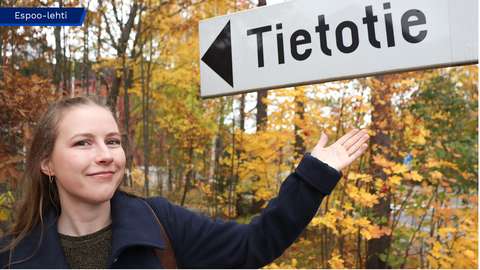First comes the place, then the name

Matinkylä, Espoonlahti, Suurpelto. The names testify to the local history of each area and highlight their special characteristics and culture. But why are there space-related names like Komeetankatu and Avaruusrata in Olari?
“The name should primarily be functional and informative, not fun or clever,” says Name Planner Aurora Salmi.
Tapio is the king of the forest, which is why Tapiola has a name that relates to animals and Finnish legends. In Espoonlahti, the names reflect the proximity to the sea, and there are church-related names around the local church. In Olari, the names suddenly seem very farfetched, but Salmi explains that there is a cultural-historical reason for that too.
“There was once a farm there called Solberga (sun hill), hence the names that relate to the sun and space,” she says.
When you start looking, there are names everywhere: streets, parks, buildings, commercial products, and public services. Everything we want to identify needs a name. Salmi has worked for the City of Espoo for three years and is one of the city’s two name planners. She works in close cooperation with her colleague Sami Suviranta.
Multi-faceted work
“I cannot take credit for the names of any existing areas, as the planning projects for large areas can take years. These are slow cooperation processes,” Salmi says.
In addition to the names used in detailed plans, name planners are asked to provide their views on issues such as names of schools and bus stops.
When a new street is built in an existing area, it needs a new name.
“We study the history of the area and draw inspiration from existing names and names that are already used by locals,” Salmi describes the process.
Names associated with a specific time
Geologintie (geologist’s road) was recently added to the detailed plan of Otaniemi, which has long included streets referring to professions, such as Kivimiehentie (stone mason’s road) and Betonimiehenkuja (concrete mason’s path). The main street in the area is Miestentie (men’s road).
“The starting point is that the name should not be translated but designed in both Finnish and Swedish at the same time. A direct translation of Miestentie would be männens väg, but the street name should also be linked to other names in the area. The name Miestentie – Karlfolksvägen contains the words mies and karl, referring to the adjacent street, which is Kivimiehentie – Stenkarlsvägen,” Salmi says.
Bilingualism offers inspiration
On the other side of Otaniemi, there is a street named Sähkömiehentie – Strömkarlsvägen (electrician’s road). The name is a play on words dating back more than 50 years and reflecting the humour of technology students who live and study in the area. Sähkömies, an electrician, is a technical profession, but besides referring to electric current, the Swedish name ström also alludes to a flow laboratory that used to be located there and also to fresh river water. According to folklore, Strömkarl is the ruler of the river.
In 2018, Strömkarl was joined by its female counterpart, Strömfru, as a path following the shoreline in Otaniemi was named Vedenemonreitti – Strömfrustråket.
“Sometimes the stories and connections are only revealed when you look at the names in both languages,” Salmi says.
Text: Nora Gullmets. Video: Tero Ikäheimonen.
This article has originally been published in the Espoo-lehti 3/2024. Read other articles in the Espoo-lehti.